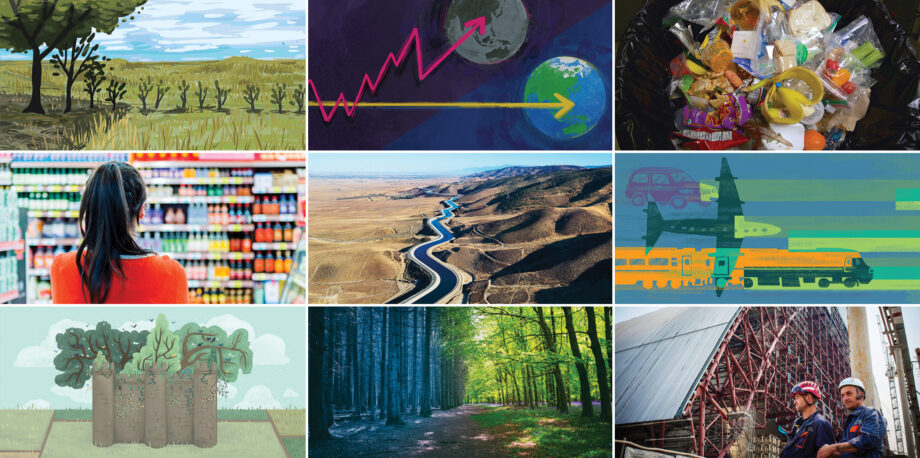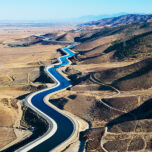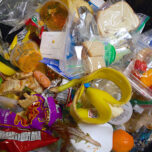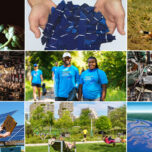December 28, 2019 — In the past year, environmental change has been present in more ways than one. Greenland’s ice sheet is melting faster than expected, bird and insect populations are rapidly declining, and Australia is experiencing devastating wildfires. Yet at the same time we have seen global movements like climate strikes take hold, while renewable energy has started to outpace coal burning, and governments have passed legislation to ban single use plastics.
At Ensia, we seek to shine a light on environmental news from around the world in a way that inspires and informs the search for solutions. Though times are troubling, we are hopeful that the future can be brighter if we learn from the past and from each other. In that spirit, we have compiled a list of our top 10 most-read stories in 2019, all of which share important ideas worth reflecting on again.
#10: Opinion: How do we convince climate change deniers? That’s the wrong question.
Even while swimming in a sea of evidence that climate change is real, some people remain unconvinced. Is there a way to better cultivate conviction that climate change is in urgent need of our attention? In her recent opinion piece, physician Laalitha Surapaneni takes this question and turns it on its head, contending that the solution to climate change does not lie in getting more people to believe in it.
Instead, she argues that the key can be found in action. When you have the urge to argue with climate deniers, she recommends, “[e]stimate how many minutes you would likely invest in this ‘discussion.’ Then — don’t.” Your time is better spent working for change than arguing.
#9: The term “resilience” is everywhere — but what does it really mean?
It seems like everyone is talking about resilience these days when it comes to environmental change. But what exactly do we mean by that term?
In this comprehensive explanation, sustainability scholar Kate Knuth presents the most common uses of the word resilience. Common to everything from ecology to urban planning, it usually refers to shocks and stresses, but it requires clarification based on the context.
#8: Opinion: Why we should save the last tiny scraps of nature
Furthering the conversation on land preservation and fragmentation, distinguished ecologist William Laurance synthesizes a number of explanations for why small ecosystem fragments are worth saving. He writes: “New research is revealing that those small patches of vanishing habitat are far more important to our environment and to us than we’d previously understood.” Among other reasons to save them, he offers numerous examples of rare species that exist only within small habitat fragments.
#7: Nuclear power offers an abundant supply of low-carbon energy. But what to do with the deadly radioactive waste?
Nuclear power has benefits as a low-carbon source of electricity, but it is undeniable that there are also a number of drawbacks. Primary among them is the radioactive waste it produces.
In this feature, environmental journalist John Vidal brings to light recent updates in this area, including experimental ventures of entrepreneur Liz Mueller and her startup Deep Isolation, which aims to use fracking deep-drilling technology to store stockpiled canisters of nuclear waste. Other options explored range from reducing radiotoxicity via lasers to shooting waste into space. Despite the brainpower behind nuclear, there is still little consensus on how waste can and should be disposed of.
#6: Are bioplastics better for the environment than other plastics?
Included in the recent wave of “eco-friendly” products is more sustainable packaging, which is often made of bioplastics. In this feature story, journalist Anja Kreiger clarifies that the term bioplastic has multiple definitions and notes that even if bioplastics are labeled biodegradable, most require a specific set of conditions to degrade. Though there are still niche benefits to certain products, in determining the environmental impact that they will have, she says, “[t]here’s no doubt, bioplastics are still plastics.”
#5: Opinion: Current proposals to plant trees to fight climate change are badly misguided
A commonly proposed strategy for mitigating climate change, tree planting offers opportunities for large-scale carbon sequestration. Yet biologist William Bond voices many concerns with projects such as the Bonn Challenge, which aims for reforestation of degraded and deforested land in Africa.
In addition to potentially reducing biodiversity and increasing fire risk, planting new forests in areas that have naturally been prairie or savanna can create more of a warming effect than that which characterized preceding lighter-colored vegetation. Bond suggests not only wariness of such programs, but prioritization of green energy as an alternative form of environmental action.
#4: Opinion: Sooner or later, we have to stop economic growth
Many environmentalists believe economic growth and environmental sustainability can work hand in hand. But with a finite planet in mind, author and speaker Richard Heinberg says society will have to make more drastic changes.
In calling for an end to economic growth, Heinberg voices alternatives, including using happiness indexes or equity as determinants of economic well-being instead of monetary growth. Changing the ways we look at the economy, he claims, will be better for the environment and for people as well.
#3: Opinion: Instead of flight shaming, be thoughtful about all travel
Many consider flying the most devastating action in terms of individual carbon footprints. While the related emissions are undeniable, this article argues that the climate impact of flight is comparable to that of every other common mode of transportation.
In this opinion piece, academic researchers Navin Ramankutty, Elena Bennett and Lior Silberman outline how factors such as passenger number and distance traveled affect overall efficiency and environmental impact. They argue that, instead of never flying, we should think through all travel, considering both direct and indirect environmental impacts.
#2: School food waste is a big problem. Here’s what we can do about it.
Many public schools in the U.S. are working to become more sustainable, and one area that demands attention is food waste. In regard to total waste, “[b]y one estimate, [something] like 26 percent of an NSLP-participating school’s food budget, or US$1.2 billion per year worth of food thrown away in schools across the U.S. ”
In this feature, journalist Lela Nargi brings the issue of school food waste to light, pointing out that changes can not only teach children sustainable life skills at an early age, but also boost resources available to feed hungry kids nationwide. Programs that have been proven to cut down on waste include everything from farm visits and discussions of where food comes from to redistribution of and free access to unopened leftovers.
#1: America uses 322 billion gallons of water each day. Here’s where it goes.
Ensia’s most-read story of the year traces the pathways of American water use, ranging from household to industrial sources. In this piece, Ensia publisher Todd Reubold includes maps and data visualizations to paint a picture of where our water goes in the U.S. — and uncovers a number of surprising data points and opportunities for improved water conservation along the way.
Related Posts
Ensia shares solutions-focused stories free of charge through our online magazine and partner media. That means audiences around the world have ready access to stories that can — and do — help them shape a better future. If you value our work, please show your support today.
Yes, I'll support Ensia!



